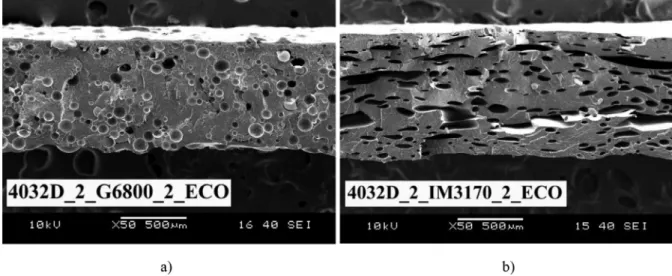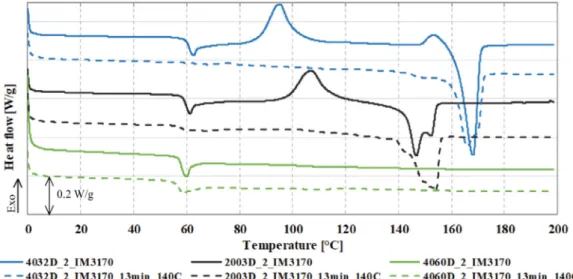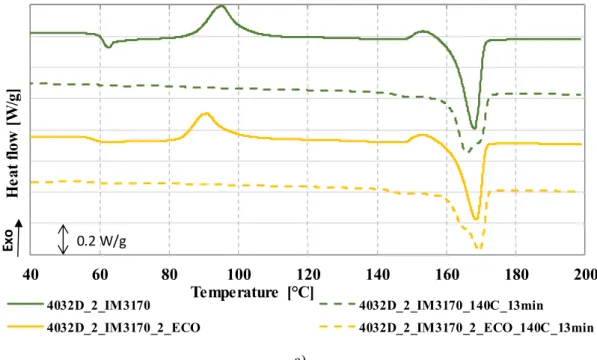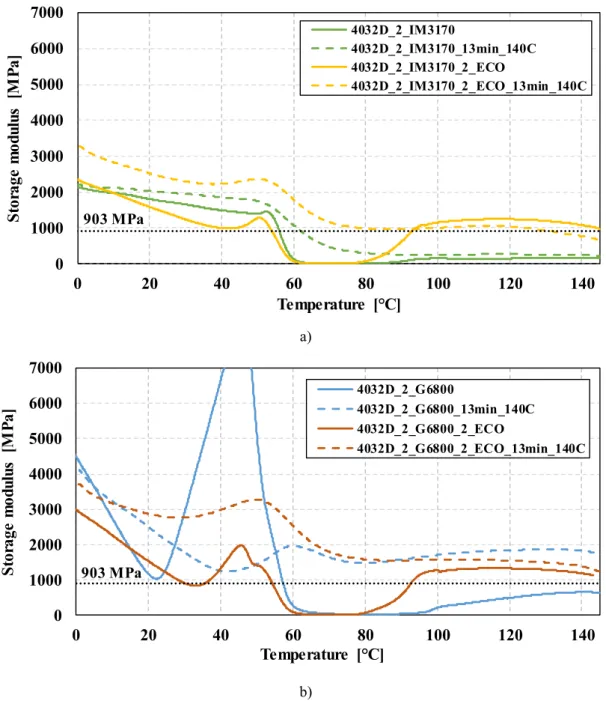ContentslistsavailableatScienceDirect
Polymer Degradation and Stability
journalhomepage:www.elsevier.com/locate/polymdegradstab
Improving the heat deflection temperature of poly(lactic acid) foams by annealing
Tamás Péter
a, Katalin Litauszki
a, Ákos Kmetty
a,b,∗aDepartment of Polymer Engineering, Faculty of Mechanical Engineering, Budapest University of Technology and Economics, M ˝uegyetem rkp. 3., H-1111 Budapest, Hungary
bMTA–BME Research Group for Composite Science and Technology, M ˝uegyetem rkp. 3., H-1111 Budapest, Hungary
a rt i c l e i nf o
Article history:
Received 16 April 2021 Revised 31 May 2021 Accepted 1 June 2021 Available online 6 June 2021 Keywords:
Poly(lactic acid) Foam Annealing
Heat deflection temperature Cold crystallization
a b s t r a c t
Poly(lactic acid) isapromising biopolymer butduetoits low heatdeflection temperature,the usage of PLA-based productsis limited. Inthe case of bulk products, annealingis an effective way to in- crease the heat deflection temperature. Our aim was to improve the heat deflection temperature of poly(lacticacid)foams byannealing.Inthisstudy,weshowed thatD-lactide contentaffectsthe crys- tallinity offoam structuresin the same way it affects the crystallinity ofbulk PLA. Lower D-lactide contentresultedinahigherdegreeofcrystallinity.Annealingproved tobean effectivewaytoinduce coldcrystallization.TheheatdeflectiontemperatureswerecalculatedwiththeuseofDMA,whichpro- ducedmoreaccurateresultsthantheHDTdevice.Outstandingheatdeflectiontemperatureresultswere achieved (from 54°C to 131°C) with the use of annealingof chemically foamed PLAfoams (1.4% D- lactide content) containinganucleating agent. The excellent results can be explainedwith increased crystallinity, whichexceeded 40%.Also, no signs ofthermal degradationwere found after successful annealing.
© 2021TheAuthors.PublishedbyElsevierLtd.
ThisisanopenaccessarticleundertheCCBY-NC-NDlicense (http://creativecommons.org/licenses/by-nc-nd/4.0/)
1. Introduction
As a result of increasing global environmental consciousness, biopolymersaremoreandmorerecognizedandused[1].Theyare producedfromrenewableresourcesand/orbiodegradable.Biopoly- mershelpreducelandfillwasteandthepolymerindustry’sdepen- dance on the oil industry. In industrial composts, biodegradable polymer waste is broken down into water, humus, carbon diox- ideandother,environmentallyneutralcompounds[2].Asbiopoly- mer research hasonly acceleratedinthe past fewdecades, poly- mersthatcanbeprocessedontraditionalequipmentwithminimal modificationarestillpreferred.Oneofthemostpromisingbiopoly- mersispoly(lacticacid)(PLA)[3],whichhasmechanicalproperties similar to traditional,mass-producedplastics [4].Poly(lacticacid) canbeproducedfrombiomassandisbiodegradableafteruse.Pro- ducing PLAfrom rawmaterials requires25–55% lessenergythan traditional plastics made fromcrude oil [5]. The main disadvan- tagesof PLAare its brittleness andlow glasstransitiontempera- tureofapprox.60°C.PLApartslosetheirstiffnessattemperatures
∗Corresponding auhtor.
E-mail address: kmetty@pt.bme.hu (Á. Kmetty).
aboveTg,thereforetheycannot beused atelevated temperatures (>60°C).Duetothisdrawback,improvingtheheatdeflectiontem- peratureofPLAcouldmakeitsusemorewidespread.
Poly(lacticacid) issemicrystalline, yet itrarely hasahigh de- greeofcrystallinityafterprocessing,duetoitsslowcrystallization [6]. The ratio of the building block isomers of the molecule, D- lactideandL-lactide,determinesits abilitytocrystallize[7].Com- mercial processes overwhelmingly yield L-lactide, therefore PLA grades are usually characterised by their D-lactide content [5]. More than 10% D-lactide results in amorphousPLA [5].A higher degree of crystallinity generally improves mechanical properties andincreasestheheatdeflectiontemperature.Polymerprocessing usually includes fast cooling, which retards crystallization. Post- process annealing, a method for improving crystallinity, is being investigatedbyresearchers[8-11].Hajba [8]conductedisothermal annealingexperiments(80–140°C,PLAgrade:Ingeo3001D,1.4%D- lactide). His results indicate that annealing is an effective treat- ment to increase the heat deflection temperature. The improve- ment in heat deflection temperature (HDT) resembles a sigmoid curveasafunctionofthedegreeofcrystallinity.Between37%and 42% of crystallinity, heat deflection temperature increased from approx. 60°C to above 120°C. The cause of the sudden increase
https://doi.org/10.1016/j.polymdegradstab.2021.109646
0141-3910/© 2021 The Authors. Published by Elsevier Ltd. This is an open access article under the CC BY-NC-ND license ( http://creativecommons.org/licenses/by-nc-nd/4.0/ )
was found to be
α
’-/α
-crystal polymorphism and the growth in spherulite size. Tang etal. [9]examined PLA crystallization from melt at an isothermic 105°C. Ethylenebishydroxystearamide was usedasnucleatingagentin1wt%,andannealingtimevariedfrom 0.5to 120minutes.Theyfound that theuseofnucleating agents resulted in ahigher degree ofcrystallinity(40%) and fastercrys- tallizationkinetics.NeatPLA(Ingeo2002D, 1.5–2% D-lactide)had aheatdeflectiontemperature(HDT-B)of51°C,whichincreasedto 93°C as the nucleating agent was added. The nucleating proper- tiesoftalcumandstarchinannealedPLA(Ingeo4032D,D-lactide:1.4%) were examined by Kanget al.[10]. The initial 2.4% degree of crystallinity increased to 36% and 26% by 1 wt% talcum and starch,respectively.Accordingtomicroscopicimages,theeffective- ness ofthenucleating agentisdeterminedby itsshape,wettabil- ity,andeffectivenessofdispersion.Experimentswithdifferentan- nealingparametersshowedthatcrystallizationkineticshasanop- timum temperature, at whichthe process takesplacethe fastest.
Multiple researchers[12,13] foundthat theaddition ofnucleating agentscausestheenthalpypeakofcoldcrystallizationtooccurat lower temperatures,by asmuch as14°C. The heterogeneous nu- cleilowerthefreeenthalpyneededforcrystallization.Nascimento etal.[11]examinedtherecyclingofPLAandconductedannealing experiments.Itisimportanttomeasurewhethermultipleprocess- ing cycles (recycling) cause significant changes in the properties ofPLA. TheDSCcurves oftheannealed(6 hours, 120°C)samples showednosignificantdifference,thereforemultipleprocessingre- sulted inno changeinthermalpropertiesin thiscase. Annealing increasedthedegreeofcrystallinityfrom1% toabove33%,which resultedina10°Cincreaseintheheatdeflectiontemperature.
In many aspects, foams are an important segment of poly- mer products. Dueto their structure, foams inherently have bet- ter dynamicpropertiesandfracturetoughness[14].Theseproper- ties have furtherbenefits in the caseof poly(lacticacid), forthe bulk materialisquitebrittle.Aspolymerfoamsaredifficulttore- cycle[15],biodegradable foamscouldhelp easetheloadonland- fills. Therefore biopolymer, especially PLA foaming is intensively reserached[16].High-densityfoamscanbeproducedwithchemi- calblowingagents(CBA)orexpandablemicrospheres(EMS).These agents,mixedintothepolymerresin,canbeprocessedwithtradi- tional extrusionequipment.Thismethod doesnot requireexpen- sive gas-injectionsystems,making foamingmoreavailable. Chem- ical blowing agents usually produce high density (>0.5 g/cm3) foams,wheredensityasafunctionofCBAcontenthasaminimum [4,17].Thispoint,afterwhichdensitybeginstoincrease,isthegas retention limit.Higher CBAcontent resultsincellcoarsening,the process of gas diffusing from a smaller cell into a neighbouring biggercell, duetohigherpressure. Thisresultsinmacrocavities, theinhomogenouscellstructureincreasesdensityandimpairsme- chanicalproperties[18].Cellstructureisalsoaffectedbyextrusion speed,astheCBAmaynothavesufficienttimetofullydecompose [4].
To sum up, if the brittleness of PLA could be counteracted by foaming, and its low heat deflection temperature by anneal- ing, the resultingmaterial could beused fornumerouspurposes.
In thispresent research, PLA is foamedwith CBA and EMS. The foamsarecharacterisedbymicroscopicexamination,andmechani- calandmorphologicaltests.Heatdeflectiontemperaturesaremea- sured, and improved by annealing. The aforementioned studies were aimedatannealingbulkPLA,foamswerenotexamined.We usethreegrades ofPLAwithsignificantlydifferentD-lactide con- tents,sotheyhavedifferentcrystallizationbehaviours.Wepresent a characterisation method forheat deflectionusing dynamicme- chanical analysis(DMA). The goalofthisresearch isto reachthe region of sudden increase in the heat deflection temperature of PLA foams, which is 40% crystallinity, according to the literature [8].
2. MaterialsandMethods 2.1. Materials
Three extrusion grade poly(lactic acids) were purchased from NatureWorks LLC. (Minnetonka, Minnesota, USA): Ingeo 4032D (1.4% D-lactide), Ingeo 2003D (4.3% D-lactide) and Ingeo 4060D (12.0%D-lactide).The densityofneatPLA is1.24 g/cm3,asgiven bythedistributorandverifiedbyourmeasurements.Theexother- mic chemicalblowingagentTracel IM3170MS wasproduced by TramacoGmbH (Tornesch,Germany).Thefoaming agentisazodi- carbonamide,presentin30wt%.TheTracelG6800MSexpandable microsphereswere producedby TramacoGmbH aswell.The ma- terialoftheexpandable microspheresshell isacrylonitrile/methyl methacrylate, the encapsulatedphysical blowingagent isisopen- tane [19]. The blowing agentswere used at a fixed 2 wt% ratio, aswefoundintheliterature[20].TheEcopromoteHDcrystalnu- cleating agent was purchased from Nissan Chemical Co. (Tokyo, Japan).It iscomposed ofzincsaltsandzincoxides,andwasused inaratioof2wt%.
2.2. PLAfoaming
Priortoprocessing, PLAresinsweredried inahot airovenat 85°C for 6 hours (WGLL 45B, Huanghua Faithful Instrument Co.) to prevent hydrolysis. Foams were manufactured with a Labtech Scientific 25-30C single-screwextruder(screw diameter:25 mm, L/Dratio:30).Screwspeed was80rpm.A300mmwide flatslit diewasusedwitha4mmgapsize.Thetemperatureprofilefrom hoppertodiewas155°C–160°C–175°C–190°C.Dietemperaturewas 190°C. The extrudedfoam sheet wassolidified on a LabtechSci- entific LCR300 flat film line. The temperature of the tempering rollerwas55°C,its peripheral speedwas0.3 m/min.The periph- eralspeedofthetractionrollerwas0.9m/min.Priortoextrusion, theresinswereblendedtogetherbydrymixing,theratioscanbe foundinTable1.
2.3. Compounding
For samples containing a nucleating agent, a compound was madefromtheagentandPLAinordertobetterdistributethenu- cleatingpowder. Compounding wasdone ata screw speed of25 rpmonaLabtechLTE26-44twin-screwextruder(screwdiameter:
26mm,L/Dratio:44).Thetemperatureprofilefromhoppertodie was180°C–180°C–185°C–185°C–190°C–190°C–195°C–195°C–200°C–
200°C. Die temperature was200°C. The extrudate was pelletized withaLabtechLZ-120/VSgranulator.
2.4. Annealing
The samples were annealed ina WGLL 45B hot air oven. For sustainedflatness of the bottom ofthe specimen, they were put onasteelplatethathadbeenallowedtotakeontheambienttem- peratureoftheoven.Specimenswere cutfromthemiddleofthe extrudedfoamsheet,their longitudinalaxescorresponding tothe directionofextrusion.Annealingtimeswere5,9,and13minutes at 90°C, 110°C, and 140°C [8]. Annealed samples were cooled to roomtemperatureinopenair.Inthefollowing,annealedsamples arenamedaccordingtoannealingtimeandtemperature.
2.5. Testingmethods
Density
Density(
ρ
) wasdetermined accordingtoEq.(1) withtheuseof a SartoriusQuintix (e=0.01 mg) analytical balance. The mea- surementswererepeated5timesandtheresultsaveraged.Theex-
Table 1
Manufactured samples (BA = blowing agent, NA = nucleating agent).
PLA grade D-lactide content [%] BA type BA content [wt%] NA type NA content [wt%]
4060D 12.0 IM 3170 MS 2 - 0
2003D 4.3 IM 3170 MS 2 - 0
4032D 1.4 IM 3170 MS 2 - 0
4032D 1.4 IM 3170 MS 2 Ecopromote HD 2
4032D 1.4 G 6800 MS 2 - 0
4032D 1.4 G 6800 MS 2 Ecopromote HD 2
pansionrateandvoidfractionwerecalculatedfromthedensityof unfoamedPLAEq.(2),(3).
ρ
foam= msamsa−msl∗
ρ
dw, (1)ER=
ρ
polymerρ
foam, (2)
Vf=1−
ρ
faomρ
polymer, (3)where
ρ
foam[g/cm3]isthedensityofthefoamedpolymer,msa[g]isthemassderivedfromtheweightofthespecimeninair;msl[g]
isthemassderivedfromtheweightofthespecimenmeasuredin themeasuringliquid,
ρ
dw [g/cm3]isthedensityofthemeasuring medium,ER[-]istheexpansionrate,ρ
polymer[g/cm3]isthedesity oftheunfoamedpolymer,andVf[-]isthevoidfraction.Scanningelectronmicroscopy
We examined the cryogenic fracture surfaces of the foams by scanningelectron microscopy(SEM)(Jeol6300LA, accelerating voltage10kV).Thecross-sectionsofthefoamswerecoatedwitha gold-palladiumalloy.
Differentialscanningcalorimetry
Morphological properties were examined by differential scan- ningcalorimetry (DSC)(TA InstrumentsQ2000). The temperature rangewas0-200°C,theheatingratewas5°C/min,andthemassof thesampleswas3–6mg.Thedegreeofcrystallinitywascalculated accordingtoEq.(4).InthecaseofsyntacticfoamsmadewithEMS, theeffectofthesphericalcellshellswasneglected.
Xc=
Hm−
Hcc
Hkr ∗100, (4) where Xc’ [%] is the degree of crystallinity after manufacturing, Hm [J/g] is the melting enthalpy, H100% [J/g] is the theoreti- calmeltingenthalpyof100%crystallinePLA(93J/g[4]),andHcc [J/g]isthecoldcrystallizationenthalpy.
Heatdeflectiontemperature
The heat deflection temperature(HDT) was measured with a Ceast HV3 6911.000 device. The measurements were repeated 3 times and the results were averaged. The size of the specimens was 80mm × 15 mm, spanlength was64 mm in flatwisecon- figuration.Loadingstresswas1.8MPa,andthefinaldeflectionwas 0.68mmaccordingtotheISO75HDT-Astandard.Theheatingrate ofthesiliconeoilwas2°C/min,thestartingtemperaturewas30°C, andinitialsoakingtimewas5minutes.
Dynamicmechanicalanalysis
Dynamic mechanical analysis (DMA) was carried out on a TA Instruments Q800. Specimen size was 60 mm × 10 mm. Span length was35 mm in dual cantileverconfiguration. The temper- aturerangewas0–150°C,theheatingratewas2°C/min,andinitial soaking time was5 minutes. The amplitude was20
μ
m, withafrequencyof1Hz.
Wecalculatedthestoragemodulustocharacterisetheheatde- flectiontemperatureaccordingtoEq.(5).
EHDT−A= FL3
48b12h3f=
σ
L26h2f =903MPa (5)
whereF[N]istheforceapplied,
σ
[MPA]istheinducedstress,b[mm]is the widthofthe specimen,h [mm]is the height ofthe specimen,L[mm]is thespan length,EHDT-A [MPa]is thestorage modulus,andf[mm]isthedeflection.
Thermogravimetricanalysis
Thermalstabilitywascharacterisedbythermogravimetricanal- ysis(TGA)withaTAInstrumentsQ500.Samplemasswas3–6mg, andthetemperaturerangewasTRoom–600°C.Theheatingratewas 10°C/mininameasuringmediumofair.
Characterisingcellstructure
CellstructurewascharacterisedwithSEMimages.Weusedthe numberofnucleatedcellstocalculatecell populationdensityac- cordingtoEq.(6)[17].
Nc=
n·MA
32· 1
1−Vf (6)
whereNc [cells/cm3]isthecellpopulationdensity,n[cells]isthe number of cells counted in the recorded image, A [cm2] is the cross-sectionareaofthesample,M[-]isthemagnificationfactor, andVf[-]isthevoidfraction.
3. Results
3.1. EffectofD-lactidecontentonthecellstructureoffoamedPLA
We examined PLA foams made with the chemical blowing agenttodeterminetheeffectofD-lactidecontenttothecellstruc- ture,assyntacticfoamsarelesssensitiveinthisregardtothetype ofPLAused.2wt%CBAwasusedtocreatePLAfoamswithallthree grades,and2wt%expandablemicrosphereswith4032D.
Thedensitiesoffoamedpolymersmadewithazodicarbonamide wereintherangeof0.8–1.0g/cm3,whichcorrespondswithlitera- turedata[4].ThecorrelationofdensityandD-lactidecontentcan be seenin Fig.1.We found thathigher D-lactide contentcaused higherfoamdensity.MoleculescontaininglessDisomerarebetter suitedto crystallize,whichresults indifferentmelt andmechan- ical properties.Thegrowing cellsare lesslikely to rupture,caus- ingthestructuretoholdmoregas,thusresultinginlowerdensity thaninthecaseofamorphousPLA.Adensityabove1.0g/cm3was achieved in the caseof the syntactic foam, this kindof blowing agentis usually added inhigher ratios to achieve lower density.
DensityvaluescanbeseeninTable2.
The presentfoaming method resulted in high-density, closed- cell foams. Using SEM images,we found that thesemicrystalline PLAgradeshadlargeraveragecellsizethantheamorphous4060D (0.116mmand0.096mm).Thestandarddeviationofcellsizewas quitehigh,whichsuggestsaheterogenousstructure,whichcanbe clearlyseeninFig.3.Arudimentarycore–skinstructurewasalso
Table 2
Density-related properties of poly(lactic acid) foams.
Sample name D-lactide [%] BA content [wt%] Density [g/cm 3] Expansion rate [-] Void fraction [-] Cell density [cells/cm 3]
Neat PLA - 0 1.24 1 0 0
4060D_2_IM3170 12.0 2 0.991 ±0.003 1.25 0.20 5.1 •10 5
2003D_2_IM3170 4.3 2 0.899 ±0.009 1.38 0.28 8.5 •10 5
4032D_2_IM3170 1.4 2 0.818 ±0.004 1.52 0.34 6.3 •10 5
4032D_2_G6800 1.4 2 1.147 ±0.018 1.08 0.08 3.7 •10 5
Fig. 1. Densities of PLA foams with varying D-lactide content.
Fig. 2. Core–skin structure of the cross-section of a PLA foam.
revealed by theSEM images.The outer area of thecross-section, which wascontactedandcooled the mostby thetempering roll, hadsmallercells. Here,the developinggaspressurewasnotable to overcome the increasing melt strength of the solidifying skin.
Aninhomogeneouslayer,containingrupturedandcoarsenedcells, could be found below theskin, dueto thefact that gas wasnot abletodiffuseintothesolidskin,thusitbecamelocallymorecon- centrated.Sphericalcellswithevensizeandhomogenousdistribu- tion wereformed inthecoreareaofthecross-section. Thecore–
skinstructurecanbeseeninFig.2.
As expected, fairly uniform,spherical cellswere formedwhen expandable microspheres were used (Fig. 3). In the case of this blowing agent, the cells are predefined, hencethe orderly struc- ture. Celldistribution wasnormal, a core–skin structure wasnot formed.
Lessthan7%crystallinitywasachievedineachcaseafterman- ufacturing. Differentialscanning calorimetry resultsare shownin
Table 3
Crystalline portion of as-manufactured foams.
PLA grade D-lactide content [%] H cc[J/g] H m[J/g] X c’[%]
4060D_2_IM3170 12.0 0 0 0
2003D_2_IM3170 4.3 24.4 27.6 3.4
4032D_2_IM3170 1.4 30.4 35.9 6.0
4032D_2_G6800 1.4 23.7 29.4 6.2
Table 4
Results of differential scanning calorimetry of PLA foams.
Sample name D-lactide [%] T g[ °C] T cc[ °C] X c’[%]
4060D_2_IM3170 12.0 57 - 0
4060D_2_IM3170_13min_140C 12.0 53 - 0
2003D_2_IM3170 4.3 59 107 3.4
2003D_2_IM3170_13min_140C 4.3 56 - 32.9
4032D_2_IM3170 1.4 60 95 6.0
4032D_2_IM3170_13min_140C 1.4 59 - 38.4
4032D_2_IM3170_30min_140C 1.4 59 - 37.5
4032D_2_IM3170_60min_140C 1.4 60 - 38.2
4032D_2_G6800 1.4 55 101 6.2
4032D_2_G6800_13min_140C 1.4 59 - 41.3
Table 3. Cold crystallization and melting enthalpies are nearly equal, therefore crystallization almost entirely took place in the DSCdeviceduringtheanalysis.
3.2. Improvingcrystallinitybyannealing
Significantcrystallineportiondidnotformduringmanufactur- ing, duetothe slowcrystallizationof poly(lacticacid).Therefore, we used post-manufacturing annealing to increase the degree of crystallinity.It was performedin a hot air oven for5, 9,and 13 minutes, at90, 110, and 140°C accordingto the literature. After- ward,thesampleswerecooledtoroomtemperatureinopenair.
3.2.1. Measuringtheheatdeflectiontemperature
The heat deflection temperature of PLA foams produced with the chemical blowing agent was measured with an HDT device.
Tendencies were best shown by 4032D, containing the lowest amount of D-lactide Fig. 4. The heat deflection temperature in- creased with longer and higher temperature annealing. The ten- dencycan be clearlyseen,butthe improvementitself isnot sat- isfactory. The maximum heat deflection temperature was59.1°C.
Theseresultsled usto believe thatthe degreeofcrystallinityre- quiredforthesuddenincreaseofheatdeflectiontemperaturewas notachieved.Amaximumcrystallinityof38.4%wasshownbyDSC (Table 4). We experimented withannealing at140°C for30 and 60 minutes to further increase the heat deflection temperature, but the HDT value reached a plateau at 60°C. However, due to the longer annealing times, we had to take thermal degradation intoconsideration.Thermogravimetricanalysiswascarriedout on as-manufacturedandannealed (13, 30,and60minutesat 140°C) 4032DfoamsamplesmadewithCBA(Fig.5).
TGA showed that at 140°C, annealing had not caused ther- mal degradation up to 30 minutes annealing time. On the con- trary,thermalstabilityslightlyincreasedduetomoreperfectcrys-
Fig. 3. Differences in the cell structure of PLA foams made with expandable microspheres (a) and an exothermic chemical blowing agent (b).
Fig. 4. HDT results of annealed 4032D foams made with 2m% IM3170 CBA.
tal variants [8].Degradationcan be seen inthe sampleannealed for 60 minutes,as its weight loss shiftedto lower temperatures.
Therefore, 13 minutes annealing at 140°C wassufficient for cold crystallization to fullytake place,whilst the foamedpolymer did
not suffer thermal degradation. No notable change can be seen ontheTGAcurvesinthedecompositiontemperaturerangeofthe chemical blowingagent, proving that the CBA was fully decom- posedduringextrusionandnoactiveresidueremainedinthesam- ples.
3.2.2. Theeffectofannealingoncrystallinity
Differentialscanningcalorimetrywasused togive insightinto the HDT results.The glass transition temperaturewas measured, and cold crystallization and melting were characterised. The de- greeofcrystallinitywascalculatedforas-manufacturedandpost- annealedsamples.Theeffectofannealingwasexaminedonsam- ples heated for 13 minutes at 140°C, as heat deflection tem- perature did not increase at longer annealing times. A mostly amorphous (Xc’ < 7%) structure was found in the case of as- manufactured samplesmade witha chemicalblowing agent. The crystalline portion of the low D-lactide 4032D foam was only 6.0% (Table 4). Samples produced from 4060D, containing 12.0%
D-lactide,were fullyamorphousevenafterannealing(Fig.6).An- nealingcausedsignificantcoldcrystallizationinthecaseof2003D and4032D,resultingin32.9%and38.4%crystallinity,respectively.
These results are consistent withthat of Nascimento et al. [11], who annealed PLA with a D-lactide content similar to that of 2003D, and achieved 33% crystallinity. We evaluated the sam-
Fig. 5. Thermogravimetric results of annealed PLA foams.
Fig. 6. DSC curves of as-manufactured and annealed PLA foams made with CBA.
Fig. 7. Changes in cell shape of annealed PLA foams made with CBA a) 4060D_2_IM3170, b) 4060D_2_IM3170_13min_140C, c) 4032D_2_IM3170 and d) 4032D_2_IM3170_13min_140C.
ples annealed for 30 and 60 minutes to find out whether crys- tallinity had increased even more, but found only marginal im- provement. 13minutesat140°Cwastheoptimum,asthelack of thecoldcrystallizationpeaksuggeststhat crystallizationwasfully completed.
3.2.4. Effectofannealingoncellstructure
Nochangesincellstructurewerefoundinthecaseofsemicrys- talline PLAfoams after annealing.The shape of the cellswasal- teredinthe caseofthe amorphous4060Daswell asinthecase of4032D.Withoutthestiffeningeffectofcrystallinestructures,the flattened,ellipsoidcells,seekingminimalsurfaceenergy,wereable
Fig. 8. DSC curves of 4032D PLA foams made with chemical blowing agent (a) and expandable microspheres (b).
totakeonasphericalshape(Fig.7).Thusthethicknessoftherub- beryfoamhadalsoincreased.
To sumup, the annealing process was mostpromising inthe case of4032D PLA foams, wichcontain a low amount ofthe D- lactide isomer.The improvementinHDT, however,wasnot satis- factory.Hereinafter,wecontinuedourexperimentsusingacrystal nucleating agenttofurther improvecrystallinityandincreasethe heatdeflectiontemperatureofpoly(lacticacid)foams.
3.3. ImprovingHDTwithacrystalnucleatingagent
Thepreviouslydiscussedresultsshowthatannealingcaneffec- tively increase the degreeof crystallinityofPLA foams.However, thecrystallinityneededforthesuddenincreaseoftheheatdeflec- tiontemperaturewasnotreached[8,9].Therefore,weadded2wt%
crystalnucleatingagent(NA)toreachthatthreshold.Theeffectof theadditionofthenucleatingagentonthedensityofthefoamed polymerscanbeseeninTable5.
Fig. 9. DMA results of chemical (a) and syntactic (b) PLA foams (903 MPa represents the storage modulus in the HDT-A test).
Table 5
Density of PLA foams with a nucleating agent.
Sample name BA content [wt%] NA content [wt%] Density [g/cm 3] Expansion rate [-] Void fraction [-] Cell density [cells/cm 3]
Neat PLA 0 0 1.24 1 0 0
4032D_2_IM3170 2 0 0.818 ±0.004 1.52 0.34 6.3 •10 5
4032D_2_IM3170_2_ECO 2 2 0.925 ±0.004 1.34 0.25 1.6 •10 6
4032D_2_G6800 2 0 1.147 ±0.018 1.08 0.08 3.7 •10 5
4032D_2_G6800_2_ECO 2 2 1.070 ±0.004 1.16 0.14 1.1 •10 6
Inthecaseofsyntacticfoams,anincreaseof10
μ
minaveragecell diameter wasfound (53→63
μ
m) in thesamples containingNA.Thisresultedinalowerdensityfoam,butdensityincreasedin thecaseoffoamsmadewithCBA.Thiscanbeexplainedwiththe differenceinviscosityandmeltpressureintheextruderdie.
3.3.1. Effectofthenucleatingagentoncrystallinity
Asexpected,ahigherdegreeofcrystallinitywasachievedwith the nucleating agent, exceeding our goal of 40% (Table 6). 40%
is the threshold for the sudden increase of heat deflection tem- perature in this case. The cold crystallization peak of the sam- ples shifted to temperatures10°C lower (Fig.8), which is aphe- nomenon well documented by literature. This can be explained by the increased ability to crystallize in the presence of het- erogeneous nuclei. The annealed samples show no cold crys- tallization peak, once again proving that the process had been completed.
Table 6
DSC results of annealed PLA foams with a nucleating agent.
Sample name D-lactide [%] T g[ °C] T cc[ °C] X c’ [%]
4032D_2_IM3170 1.4 60 95 6.0
4032D_2_IM3170_13min_140C 1.4 59 - 38.4
4032D_2_IM3170_2_ECO 1.4 59 91 10.7
4032D_2_IM3170_2_ECO_13min_140C 1.4 58 - 41.7
4032D_2_G6800 1.4 55 101 6.2
4032D_2_G6800_13min_140C 1.4 59 - 41.3
4032D_2_G6800_2_ECO 1.4 56 90 11.3
4032D_2_G6800_2_ECO_13min_140C 1.4 61 - 40.0
Table 7
DMA results of PLA foams, where HDT-A ∗represents the heat deflection temperature calculated from the storage moduli (150 + results were above the upper limit of the measurement).
Sample name Storage modulus at 25 °C [MPa] Storage modulus at T g+ 10 °C [MPa] Calculated HDT-A ∗[ °C]
4032D_2_IM3170 1724 11 56
4032D_2_IM3170_13min_140C 1980 544 62
4032D_2_IM3170_2_ECO 1410 4 54
4032D_2_IM3170_2_ECO_13min_140C 2392 1797 131
4032D_2_G6800 1324 77 57
4032D_2_G6800_13min_140C 2123 1682 150 +
4032D_2_G6800_2_ECO 1201 19 54
4032D_2_G6800_2_ECO_13min_140C 2788 1751 150 +
3.3.2. MeasuringtheheatdeflectiontemperaturebyDMA
TheHDTdevicecouldnotmeasuretheheatdeflectiontemper- ature accurately enough in ourcase. The samples containingnu- cleatingagentwerecharacterisedbydynamicmechanicalanalysis, also usedby Hajba [8].The thin,uneven foam samplesproduced unreliableresults,astheHDT deviceis designedtobe usedwith standard, injectionmouldedspecimens,not withextrudedfoams.
Due tothevarying thickness, eachspecimenhadtobe measured manually,whichintroducederror,asopposedtoinjectionmoulded specimens, which have set dimensions. Furthermore, due to the foamstructure,theactualload-bearingcross-sectioncannotbeac- curatelydefined,introducingerrortothebendingresults.Also,the HDTtestonlyyieldsasingular,arbitrarytemperaturevalue,while DMAshowsthebehaviourofthematerialonawide temperature spectrum[21].
HDT-A∗ wasintroduced to represent the HDT calculated from theDMAresults.Itcanbecalculatedfromthestoragemodulusac- cordingtoEq.(5).HDT-A∗wasdefinedasthefollowing:Thetem- peraturevalue intheT∈[Tg–10,+∞) intervalofthetemperature–
storagemodulusDMAgraph,atwhichthestoragemodulusis903 MPa for the first time, and it has a negative slope. The unit is
°C. The temperature interval is necessaryto exclude false results aroundroomtemperature(e.g.4032D_2_G6800_2_ECO,Fig.9);the measurementoftheHDTnormallystartsat30°C.
Foams madefrom4032DPLAwere analysedinthisway,both made with CBA andEMS (Fig. 9). We examined regular samples andrecipescontainingthenucleatingagent,andevaluatedthede- pendencyofstoragemodulusontemperature.Thestoragemodulus ultimatelydeterminesthestiffnessofthestructureanditsheatde- flectiontemperature.Wealsocharacterizedtheeffectofthecrystal nucleatingagent.
Without annealing, overwhelmingly amorphous foams were produced by extrusion, with either blowing agent. In the sub-Tg
region, slow descent ofthe storage modulus wasregistered with increasing temperature. Thisphenomenon canbe originatedfrom secondary relaxation [22]. Approaching the glass transition tem- perature ofthePLAcausesthestoragemodulusto plummet,ren- deringthematerialunusableatelevatedtemperatureapplications.
Storagemodulusbegantoincreaseataround90°C,ascoldcrystal- lization tookplace,astheDSCresultsshow(Fig.8).Theannealed samplesdidnot showanysignofcoldcrystallization; thestorage
modulistayedroughlyconstantaboveTg,asthecrystallineportion of about 40% was responsible for load-bearing. This, once again, provesthatcrystallizationfullytookplaceduringannealing.Inthe caseoffoamsmadewithTracelIM3170MS, theresidualstorage modulusaboveTg wasaround250MPa,whichincreasedtoabove 1000MPawhenthenucleatingagentwere added—afour-foldim- provement.Thestoragemodulusof1000MPaisonparwiththat ofsomecommonplastics(polyethylene,polypropylene).
The resultsof foams madewith theexpandable microspheres were lessconsistent, although the same tendencies can be seen:
thestoragemodulusdropsattheglasstransitiontemperatureand beginstoincreaseatthethresholdofcoldcrystallization.Annealed samplesretainedastoragemodulusof1.5-1.8GPaattemperatures above Tg.The highermoduli canbe explainedwiththe spherical shellsintroducedbytheblowingagent.
HDT-A∗ values can be seen in Table 7. Annealingthe foamed polymersmadewithCBAresultedinamodestincreaseintheheat deflectiontemperature. The measured HDTwas59.1°C,while the calculated value was61°C. The relative errorof lessthan 5% can beattributedtothepreviouslydiscussedcauses.Inthecaseofan- nealing, the HDT-A∗ value rose from54°C to 131°C when 2 wt%
Ecopromote HD crystalnucleatingagentwasadded—an improve- mentof240%.
Annealing also proved to be successful in the case of foams madewithEMS.Inthiscase,bothrecipes—withandwithoutanu- cleatingagent—achievedheatdeflectiontemperaturesabove150°C, the upper limit of the measuring range. As DSC results show (Fig.8),crystalmeltingbeginsatsuchtemperature.
4. Conclusion
Inthisstudy,theeffectofD-lactidecontentwasinvestigatedin the caseof PLA foams. Annealing wasused to increase the heat deflectiontemperatureofthefoams.WefoundthatD-lactidecon- tentaffectscrystallinityinthesamewayitdoeswithbulkPLA,as lowerD-lactidecontentresultedinahigherdegreeofcrystallinity.
Annealingprovedtobeaneffectivewaytoinducecoldcrystalliza- tion,which wascharacterised byDSC andDMA.The heatdeflec- tiontemperaturewasfoundtoincrease suddenlyabove40%crys- tallinity.Thenucleatingagentwasfoundeffectivetoaidinreach- ingsuchcrystallinity.Bothunannealedandannealedsamplesben-
efitedfromtheadditionofthenucleatingagent,thelatterexceed- ing40%crystallinityinthecaseof4032DPLA(1.4%D-lactide).The heat deflection temperatures were calculated using DMA, which producedmoreaccurateresultsthantheHDTdevice.TheHDTrose from54°Cto131°CinthecaseoffoamsmadewithCBA(nucleat- ingagent+annealing).Temperaturesabove150°Cwereachievedin the caseofsyntacticfoams madewithEMS.We could notdeter- mine theexact value,asit exceededthe upperlimitof themea- suringrange.Nosignsofthermaldegradationwerefoundafteran- nealing(13minutesat140°C).
Funding
This paper wassupported by theNational Research, Develop- mentandInnovationOffice(NVKP_16-1-2016-0012,K132462).The research reported inthispaperandcarried out atBMEhas been supported by the NRDI Fund (TKP2020 IES, Grant No. BME-IE- NAT) based on the charter of bolster issued by the NRDI Office under the auspices of the Ministry for Innovation and Technol- ogy. Á. Kmetty is thankful for the support of ÚNKP-20-5 New National Excellence Program of the Ministry for Innovation and Technology from the source of the National Research, Develop- ment and Innovation Fund and Á. Kmetty thanks to the support ofJánosBolyaiResearchScholarshipoftheHungarianAcademyof Sciences.
Creditsauthorstatement
Conceptualization,ÁkosKmettyandKatalinLitauszki;method- ology, ÁkosKmetty andKatalinLitauszki;validation,TamásPéter;
formalanalysis,TamásPéter;investigation,TamásPéter;resources:
Ákos Kmetty; writing—original draft preparation, Tamás Péter;
writing—reviewandediting,ÁkosKmettyandKatalinLitauszki;vi- sualization,TamásPéter;supervision,ÁkosKmetty;projectadmin- istration,ÁkosKmetty;fundingacquisition,ÁkosKmetty.
DeclarationofCompetingInterest
Theauthorsdeclarethattheyhavenoknowncompetingfinan- cialinterestsorpersonalrelationshipsthatcouldhaveappearedto influencetheworkreportedinthispaper.
Acknowledgements
We would like to thank Tramaco GmbH andInterdist Kft for providingustheTracelIM3170MSandTracelG6800MSfoaming agents.
References
[1] D. Gere , T. Czigany , Future trends of plastic bottle recycling: Compatibilization of PET and PLA, Polym. Test. (2020) 81 .
[2] R. Chandra , R. Rustigi , Biodegradable polymers, Prog. Polym. Sci. 23 (1998) 1273–1335 .
[3] J.F. Campuzano , I.D. Lopez , Study of the effect of dicumyl peroxide on morphological and physical properties of foam injection molded poly(lactic acid)/poly(butylene succinate) blends, Express Polymer Letters 14 (7) (2020) 673–684 .
[4] R. Auras , L.-T. Lim , S.E.M. Selke , H. Tsuji , Poly(lactic acid): Synthesis, structures, properties, processing, and applications, Wiley, Hoboken, New Jersey, 2010 . [5] R.M. Rasal , A.V. Janorkar , D.E. Hirt , Poly(lactic acid) modifications, Prog. Polym.
Sci. 35 (3) (2010) 338–356 .
[6] K. Yu , J. Ni , H. Zhou , X. Wang , J. Mi , Effects of in-situ crystallization on poly (lactic acid) microcellular foaming: Density functional theory and experiment, Polymer (2020) 200 .
[7] B. Ma , X. Wang , Y. He , Z. Dong , X. Zhang , X. Chen , T. Liu , Effect of poly(lactic acid) crystallization on its mechanical and heat resistance performances, Poly- mer (2021) 212 .
[8] S. Hajba , The analysis of the effect of poly(lactic acid) and filled poly(lactic acid) crystalline structure on the technical properties, Department of Poly- mer Engineering, Budapest University of Technology and Economics, Budapest, 2018 .
[9] Z. Tang , C. Zhang , X. Liu , J. Zhu , The crystallization behavior and mechanical properties of polylactic acid in the presence of a crystal nucleating agent, J.
Appl. Polym. Sci. 125 (2) (2012) 1108–1115 .
[10] Kyung Su Kang , Sang Il Lee , Tae Jin Lee , Ramani Narayan , Boo Young Shin, Ef- fect of biobased and biodegradable nucleating agent on the isothermal crystal- lization of poly(lactic acid), Korean J. Chem. Eng. 25 (3) (2008) 599–608 . [11] L. Nascimento , J. Gamez-Perez , O.O. Santana , J.I. Velasco , M.L. Maspoch , E. Fran-
co-Urquiza , Effect of the Recycling and Annealing on the Mechanical and Frac- ture Properties of Poly(Lactic Acid), J. Polym. Environ. 18 (4) (2010) 654–660 . [12] Á. Kmetty , K. Litauszki , D. Réti , Characterization of Different Chemical Blowing
Agents and Their Applicability to Produce Poly(Lactic Acid) Foams by Extru- sion, Applied Sciences 8 (10) (2018) .
[13] B. Suksut , C. Deeprasertkul , Effect of Nucleating Agents on Physical Properties of Poly(lactic acid) and Its Blend with Natural Rubber, J. Polym. Environ. 19 (1) (2010) 288–296 .
[14] A. Kmetty , M. Tomin , T. Barany , T. Czigany , Static and dynamic mechanical characterization of cross-linked polyethylene foams: The effect of density, Ex- press Polymer Letters 14 (5) (2020) 503–509 .
[15] G. Dogossy , V.A. Szabó, Investigation of Flame Retardant rPET Foam, Periodica Polytechnica Mechanical Engineering 64 (1) (2019) 81–87 .
[16] M. Nofar , C.B. Park , in: Poly (lactic acid) foaming, 39, Progress in Polymer Sci- ence, 2014, pp. 1721–1741 .
[17] L.M. Matuana , O. Faruk , C.A. Diaz , Cell morphology of extrusion foamed poly(lactic acid) using endothermic chemical foaming agent, Bioresour Tech- nol 100 (23) (2009) 5947–5954 .
[18] S.-T. L. , Chul B. P. , Foam Extrusion Principles and Practice, Second Edition, CRC Press, Boca Raton, FL, USA, 2014 .
[19] Á. Kmetty , K. Litauszki , Development of poly(lactide acid) foams with ther- mally expandable microspheres, Polymers 12 (2020) 463 .
[20] Á. Kmetty , K. Litauszki , Characterization of chemically foamed poly(lactic acid), IOP Conf. Ser.: Mater. Sci. Eng. 903 (12) (2020) .
[21] L. Csutorka , HDT érték - és ami mögötte van, M ˝uanyagipari szemle 3 (2017) 1–6 .
[22] M. Cristea , D. Ionita , M.M. Iftime , Dynamic Mechanical Analysis Investigations of PLA-Based Renewable Materials: How Are They Useful? Materials (Basel) 13 (22) (2020) .




